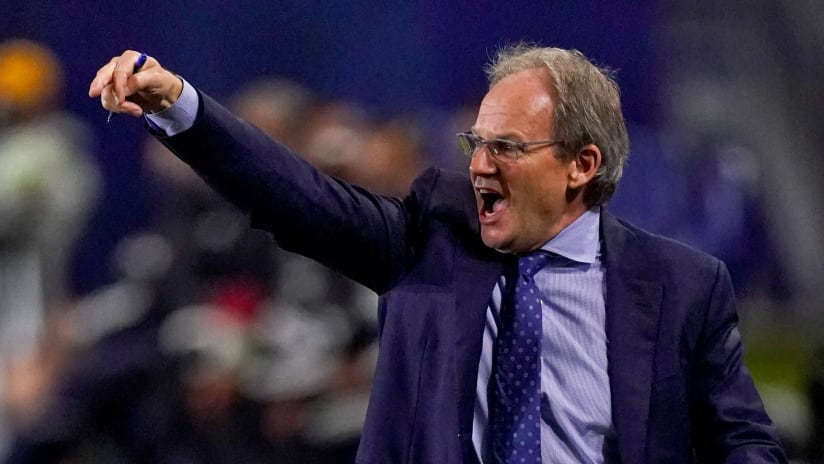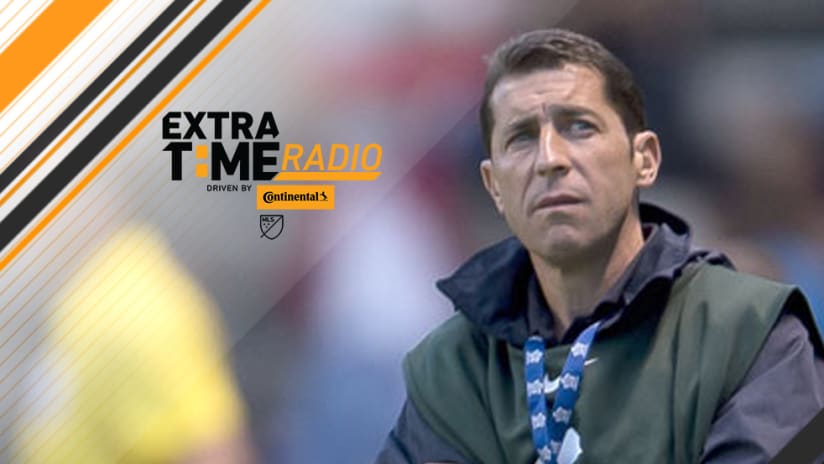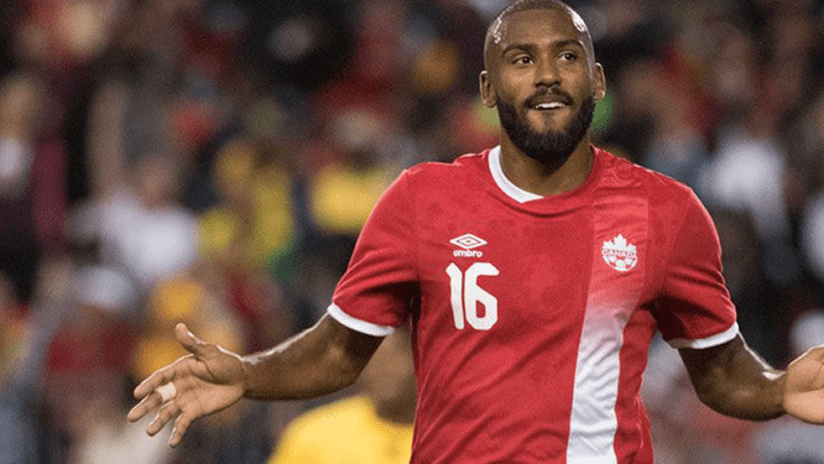HANOVER, N.J. – Jesse Marsch is putting the Red Bulls through their paces on a broiling hot, early-September morning at the club’s training center, and the mood of the session is as scorching as the day: Profanities ring out at regular intervals, challenges are meaty and players exult – loudly – when their side finds the net. They’re playing 7-v-7 plus goalkeepers in a compressed space (less than half the field), and the action is notably intense, fast-paced and competitive.
A club staffer says all of the training drills are competition-based, with season-long tallies kept by the coaches. That accounts, partly anyway, for the Braveheart–style eruptions when either side beats the ‘keeper. But there’s more to it than that. The players, as well as the club, have another long-term goal to keep them focused, to fuel and sustain their motivation.
As has been widely discussed, the Red Bulls have instituted a new system this year – a new style on the field and a new methodology off it – and the fresh approach has paid richer and faster dividends than most observers (particularly longtime fans of the club) could have imagined. The Red Bulls lead MLS in points per game, and recently became the first club to clinch a playoff spot.
While the first team is the most obvious reflection of the new system, the new approach is being integrated at all levels of the club, including their USL side, Red Bulls II, their PDL club, the Red Bulls U-23s, down to the roots of the academy.
Indeed, Leo Stolz and Stefano Bonomo, among other Red Bulls II players, are in the heated mix of that day’s first-team session, and John Wolyniec, a former New York striker who now coaches the USL team, is on the sidelines. Next to him is Bob Montgomery, head of the club’s enormously successful academy program, and new technical director Ali Curtis is here, too. All of these men play key roles in the integration of the new program.
After the session, in the comfort of his air-conditioned office, Marsch holds forth on the particulars of the “Red Bull Reformation.”
Off the field, the club has ditched the model, dating to New York’s earliest MLS days, of buying a global superstar or two and then trying to build around them.
“Now,” says Marsch, “it’s about having a system of play that is about all the players committing themselves to it, with the mentality and the belief – but also with the soccer and the tactics. It’s about fitting the players more into the club than it was about fitting the club into the players.”
On the field, the Red Bulls’ new style calls for up-tempo, high-pressing soccer. Marsch often talks about “compressing the field,” and the morning’s 7-v-7 exercise, which squeezed 14 field players and two goalkeepers into a space roughly 35 percent the size of the normal field of play, certainly trained for that.
He also frequently invokes the need to “make the game fast” and “make the game hard.”
Pressed to elaborate on what that means when his team has the ball and when it doesn’t, he replies, “When we don’t have the ball, obviously, we want to go and try to win it as fast as possible. So when a team starts to play, we run at them – we have very specific roles as to who’s supposed to go where and when certain things happen, where we’re trying to funnel the ball, where we’re trying to win it, and how the movement of the 11 is such that it compresses the field, and eliminates space and time and options.”
When New York win the ball, Marsch says they want to go to goal as fast as possible. “We want the first option to always be the most threatening play,” he said.
If they lose the ball going forward, then the process repeats itself, he says, “and it becomes cyclical. That’s what makes the game fast: that there’s no pause.”
New York training sessions therefore emphasize speed, to get the team comfortable playing at a fast pace – to acclimate them to a hectic game environment. If his team trains at 100 percent, Marsch figures, then when it comes to games, opponents used to playing at 70 or 80 are “outside of their comfort zone, and the game feels way too fast. Where for us, it feels comfortable.”
The process of integrating the approach is still ongoing – Marsch and Curtis each have less than a year on the job, after all – but it is very much in effect.
Wolyniec – scorer of the greatest goal in club history – says that in some senses he can be “almost more consistent” with the style, because the Red Bulls II are not as beholden to results as the first team is.
“We look at the opponent,” Wolyniec says, “but we’re not going to change as much as maybe the first team would because of what a certain team might do, or may not do, or [whether we’re on the] road. We look a little bit more from a long-term perspective, so our message and our training style, and what we’re trying to get across to the guys and get better at, is a bit more consistent because we don’t have to worry so much about who we’re playing on the weekend.”
Wolyniec’s players are definitely concerned with results, but since wins and losses aren’t his top priority, he has the freedom to apply the new club principles wherever and whenever he sees fit.
“If that means training harder during the week, even though we might be tired on the weekend, but I think it’s better for the players, for them to improve and get certain things down, then so be it,” he said.
It may also mean playing an academy player to get him experience in a given role in the system, even if it may not be the best choice for winning that particular game.
“I spent all of preseason with Jesse and watched what he did,” Wolyniec says. “I was in all the meetings, and I go to almost all the first-team training [sessions], so I know what they’re doing and the direction they’re going.”
Much the same can be said of academy head Montgomery, who is in charge of implementing the system in the club’s youth ranks. Montgomery attends every first-team session, and every week a different academy coach spends a week with the first team while a coach from the first team and a coach from the USL side jump into the mix for a week with the academy.
Later in the day, there’s a coaches’ meeting scheduled, in which managers from the academy, the USL team and the first team will go over the club’s physical protocols with the strength and conditioning coach. The same group has met several other times this season to hash out different concepts the club is working through – and the academy coaches are generating a curriculum for the youth teams that will also be integrated through Red Bulls II and the MLS side.
“So there’s a lot of shared experiences, a lot of shared philosophy, a lot of shared training methods, and tactics,” Marsch says.
Both Wolyniec and Montgomery say that the new approach has changed the type of young player they look for.
“We’ve had discussions in the academy,” says Montgomery, “when we bring in trialists, and [there have been] guys that we think were maybe even special players, but they won’t be able to play and fit into our system here.”
Defender Connor Lade, who joined the Red Bulls Academy in 2007 and has been with the first team since 2012, recalls a recent day at the club’s training facility:
“We were watching the U-13s play, and they’re high-pressing up the field. Our whole system is really being passed down throughout the whole academy.”
Montgomery has helped build that academy into one of the best youth programs in the US – every one of its age-group teams is ranked in the top three in the country, and Red Bulls academy teams have won four national championships – so he sees a lot of elite youth players.
Now he has a more specific set of attributes he’s looking for in an academy prospect. These include speed, fitness and, he says, “a willingness to defend, the mentality to defend, a willingness to play balls forward quickly, to get in behind [defenders].”
Hearing Montgomery tick off this list, Marsch chimes in with one of his own: “Fearlessness.”
Fearlessness is a quality Marsch himself displayed last January, when he, along with Curtis, general manager Marc de Grandpre and veteran goalkeeper Luis Robles faced a crowd of Red Bulls supporters at the now famous Town Hall meeting in the wake of last season’s shakeup.
The club had said goodbye to Thierry Henry and Tim Cahill, and hello – again – to its longstanding lack of continuity and stability. In addition to the two Designated Players, the team had parted ways with seven other players, general manager Andy Roxburgh and, most controversially, head coach Mike Petke, a beloved former player who had delivered the franchise’s only league-wide trophy in 2013 and taken the team to within a game of MLS Cup in 2014.
The fans’ emotions were raw – mostly concerning the unceremonious dumping of Petke – and Marsch was both understanding and undaunted, telling them, “I feel strongly we’re going to be able to move in a new direction to take this club to a new plateau.”
Eight months later, that new direction is clear, and the plateau, if not fully reached, is at least in sight.
The young coach wasn’t bluffing; he had an ace up his sleeve in a clear plan and a belief that he could assemble a roster with enough young, athletic players to execute that plan effectively. Thus, academy graduates like Lade, Matt Miazga, 20 and midfielder Sean Davis, 22, and young players like new left back Kemar Lawrence, also 22, have flourished in the style.
Davis has been very effective in spot duty for the team this year, and he scored two goals in a July friendly against defending Premier League champions Chelsea. That game showcased another fearless Red Bulls academy product in 16-year-old Red Bulls II professional Tyler Adams, who also bagged a goal, and made history – we’re fairly certain – as the first player still in braces ever to score against Chelsea.
While New York’s new system has sharpened these players’ development, it has helped lift Miazga and Lawrence to breakout seasons.
“His qualities really fit the way we play,” Marsch told MLSSoccer.com regarding Lawrence. “His overall awareness on the field, his assessment of plays, his ability to commit to what we’re doing tactically - it’s all at a really high level.”
The rangy Miazga was not even a starter on opening day, yet he has played his way into the lineup and the US Olympic qualifying team, and his future looks significantly brighter than it did one year ago.
“Our system, and the way that we play, has been extremely beneficial for him,” veteran New York midfielder Dax McCarty told ExtraTime Radio recently. “Because it makes the game easier for him. I think if we played a different way, he’d find himself – our center backs would find themselves – in more situations where they were one-on-one, or more situations where, tactically, we’re a little out of balance. I think the way we play – it makes everyone on the field’s job a little bit easier. … When everyone knows exactly what our job is, and what we have to do, it makes our team defending so good.”
Back to Marsch’s comments about wanting to recover the ball as fast as possible, to get toward goal as fast as possible and for his players to make the most threatening play their first option.
A play by Miazga against Orlando City on July 18 embodies much of what Marsch and Co. have been preaching all season:
Stepping up – on Kaká, no less – to cut out an outlet pass? Check. Playing it forward quickly? It doesn’t get any quicker than a first-time ball. Making the most threatening play the first option? Yahtzee.
It’s all there – not to mention superb technique, the fearlessness Marsch prizes and quality reading of the game. Miazga has taken to the new system with aplomb, flashing a newfound aggressiveness and athleticism surprising for someone his size. There was also that time when he stayed step-for-step with Sebastian Giovinco in the Red Bulls’ 3-0 win over Toronto on Aug. 15, despite a center-of-gravity disparity in that matchup that might’ve predicted TFC’s Italian star breaking ankles all night (as he’s done with many other MLS defenses this year). Didn’t happen. Miazga also helped RBNY blank David Villa in three meetings with crosstown rivals New York City FC this season.
The time was surely right for the Red Bulls’ change to an approach more in line with Real Salt Lake’s “the team is the star” credo.
“I think that the overall shift – to it being about the group – a lot of the players that have been here were hungry for that,” Marsch says.
Lade credits Marsch and Curtis with doing an excellent job, during the offseason, of laying the groundwork for how they wanted to play and how they wanted to approach the season. As a result, he says, “Everyone was on the same page going into preseason. Everyone came in with a great mentality, and it was really about the team stepping up as a whole and not necessarily relying on bigger-name guys to push you through games.”
Asked about the feeling, throughout the club, of everybody rowing in the same direction, Wolyniec chuckles: “Yeah, I mean, I think that’s most clubs’ goal – to get everybody on the same page and moving in the same direction.”
But having enjoyed (endured?) three stints with the club during his playing career, Wolyniec probably knows better than most that that wasn’t always the case with New York.
“You do have those good feelings [now], ” Wolyniec continues. “Whether we’re changing personnel or not, everybody feels like they know their role and they know what they’re supposed to be doing and how they’re supposed to go about it.”
That’s another change from previous Red Bull regimes: the players’ roles – on the field, in specific game situations – are more clearly defined than they’ve ever been. “The whole mentality, I think, is just different,” says Lade. “There’s a greater sense of clarity throughout the organization and throughout the team.”
The players are happier, the fans are encouraged by the entertaining – and successful – style they’re witnessing, and the coach, to judge by his enthusiasm for the subject, is hungry to forge ahead with the transformation.
So where does it go from here, and what’s the ultimate goal for this system?
Does Red Bull hope to eventually foster a style so distinctive that people will be able to recognize a Red Bulls player much like they would a product of the famed Ajax or Barcelona youth systems?
The integration process will expand, through all the mechanisms Marsch and his staff have discussed. As for the long-term goal, the new coach doesn’t balk: “Yeah, we’re creating an identity,” he says. “The identity is part mentality, but it’s also part soccer, and style of play. We think our identity is a good one. We want to be able to have something that when you watch our USL team, our first team, our academy teams, we want people, if they didn’t know the jersey, to say, ‘That looks like a Red Bull team.’”












